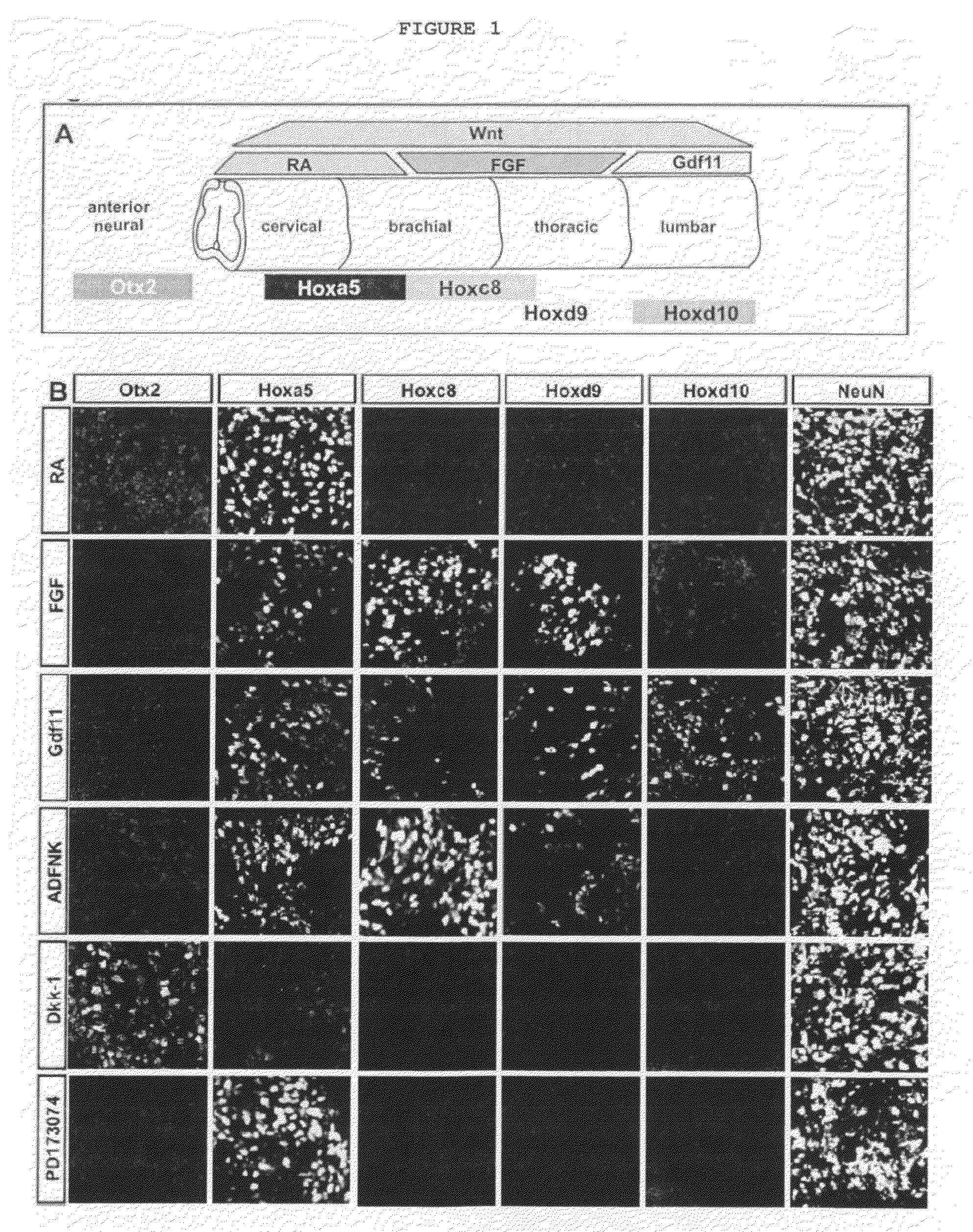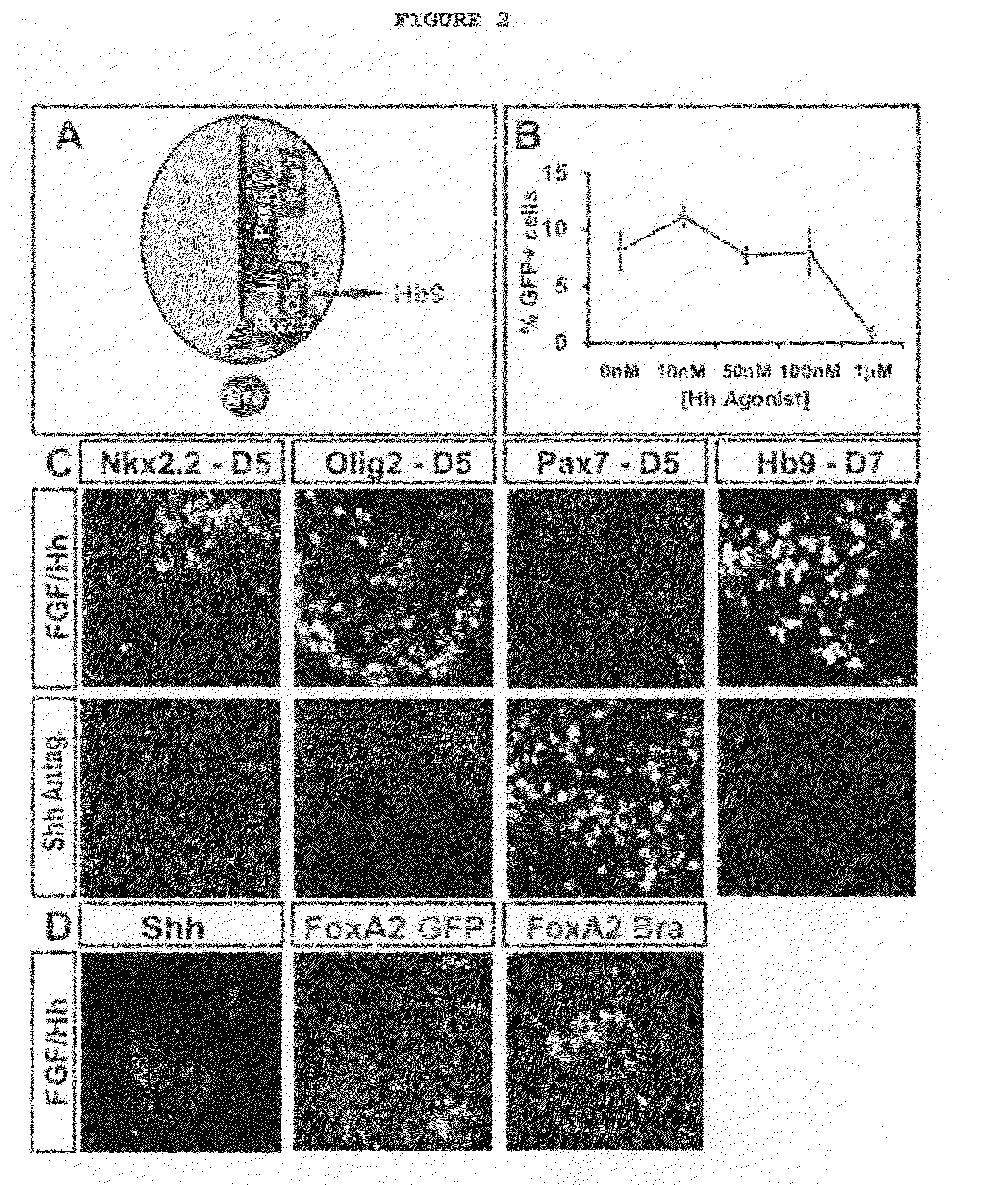Generation of brachial, thoracic and lumbar spinal motor neurons from embryonic stem cells in the absence of all-trans retinoic acid supplement
a technology of embryonic stem cells and retinoic acid, which is applied in the field of generation of brachial, thoracic and lumbar spinal motor neurons from embryonic stem cells in the absence of alltrans retinoic acid, can solve the problems of unaddressed basic study of cell differentiation into mns, and achieve the effects of reducing retinoid conditions, increasing the number of hoxd9+ mns, and blocking endogenous fg
- Summary
- Abstract
- Description
- Claims
- Application Information
AI Technical Summary
Benefits of technology
Problems solved by technology
Method used
Image
Examples
example 1
[0125]Relevant to this application, the current status of knowledge of MN subtypes and spinal AP patterning mechanisms is summarized as follows:
[0126]While generic MN identity is specified by DV patterning mechanisms, MN subtype diversity is manifested primarily along the anteroposterior axis of the spinal cord, as MNs at each spinal segment innervate distinct subsets of muscle targets. Little is currently understood about the mechanisms that underlie acquisition of AP spinal identity and about the genetic cascades that translate the progenitor AP identity to postmitotic MNs.
Columnar Identity
[0127]Traditionally MNs were classified based on two criteria: position within the spinal cord, which defines their columnar identity; and axon trajectory and pattern of muscle innervations, which defines their motor pool identity (Hollyday, 1980; Hollyday and Jacobson, 1990; Landmesser, 1978). Spinal MNs are arranged in longitudinal columns, each innervating a distinct subset of peripheral targ...
example 2
[0171]The generation of diverse neuronal subtypes relies on a precisely orchestrated interplay between extrinsic signaling factors and intrinsic transcriptional programs. This experiment shows 1) that mouse embryonic stem (ES) cells can be induced to differentiate into distinct spinal motor neuron (MN) subtypes by extrinsic signals that pattern the rostro-caudal and dorsoventral axis in vivo; 2) Wnt, FGF, and Hh signals induce brachial and thoracic spinal MN identities, as determined by expression of Hox proteins; 3) Many brachial ES cell-derived motor neurons (ES-MNs) expressed FoxP1, a marker of lateral motor column (LMC) neurons that innervate limb muscles; 4) When introduced by transplantation into the chick developing neural tube, ES-MNs settled in motor columnar territories and projected their axons along nerve branches in a pattern that conformed to their molecular columnar identity; 5) ES-MNs of LMC character acquired molecular properties of flexor carpi ulnaris and cutaneou...
PUM
| Property | Measurement | Unit |
|---|---|---|
| Fraction | aaaaa | aaaaa |
| Fraction | aaaaa | aaaaa |
| Fraction | aaaaa | aaaaa |
Abstract
Description
Claims
Application Information
 Login to View More
Login to View More - R&D
- Intellectual Property
- Life Sciences
- Materials
- Tech Scout
- Unparalleled Data Quality
- Higher Quality Content
- 60% Fewer Hallucinations
Browse by: Latest US Patents, China's latest patents, Technical Efficacy Thesaurus, Application Domain, Technology Topic, Popular Technical Reports.
© 2025 PatSnap. All rights reserved.Legal|Privacy policy|Modern Slavery Act Transparency Statement|Sitemap|About US| Contact US: help@patsnap.com



